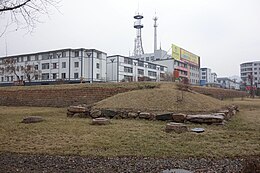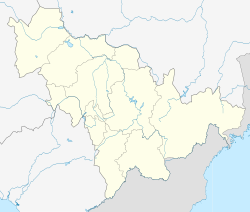Gungnaeseong (Korean: 국내성; Hanja: 國內城) or Guonei (Chinese: 國內) was the capital of the ancient Korean[1] kingdom of Goguryeo, which was located in Manchuria and the Korean Peninsula.[2] The perimeter of its outer fortress measures 2,686m.[3]It is located in present day Ji'an city, Jilin province, northeast China. Because of its historical importance and exceptional architecture, Gungnae was designated as a UNESCO World Heritage Site in 2004.[4] It is part of the Capital Cities and Tombs of the Ancient Koguryo Kingdom World Heritage Site, together with nearby Hwando Mountain City and the Onyeosan City, in modern northeast China.
| UNESCO World Heritage Site | |||||||||
|---|---|---|---|---|---|---|---|---|---|
 | |||||||||
| Location | Ji'an, Jilin, China | ||||||||
| Part of | Capital Cities and Tombs of the Ancient Koguryo Kingdom | ||||||||
| Reference | 1135-002 | ||||||||
| Inscription | 2004 (28th Session) | ||||||||
| Area | 59.24 ha (146.4 acres) | ||||||||
| Coordinates | 41°8′19.4″N 126°10′34.3″E / 41.138722°N 126.176194°E | ||||||||
| Chinese name | |||||||||
| Traditional Chinese | 國內城 | ||||||||
| Simplified Chinese | 国内城 | ||||||||
| |||||||||
| Korean name | |||||||||
| Hangul | 국내성 | ||||||||
| Hanja | 國內城 | ||||||||
| |||||||||
History
Gungnae was chosen to become the capital city by the ruler, Yuri during the 10th month of the year 3 AD. The city was sacked several times until the rise of the 19th ruler, Gwanggaeto the Great, who greatly expanded Goguryeo's territory and made it a formidable power in northeast Asia.[5] When King Gwanggaeto died in 413, his son, Jangsu of Goguryeo, inherited the throne and moved the capital down to Pyongyang in 427.[6] The city played a central role of the kingdom after the power transfer.[7]
Just before the fall of Goguryeo, Gungnae City fell to the Silla-Tang Chinese alliance when General Yeon Namsaeng, son of Yeon Gaesomun, surrendered the city in 666.[7] Goguryeo fell in 668[8] when the Tang army captured Pyongyang and took King Bojang and Yeon Namgeon into custody.[9]
Gallery
- Modern statues in the ruins
- City wall
- A corner of the ruins




